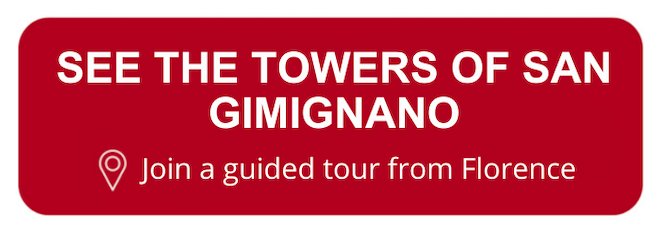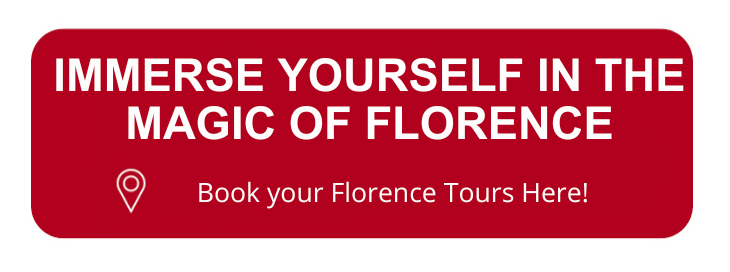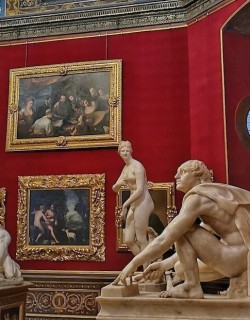With its incredible array of world-class museums, churches and palaces hosting some of the finest masterpieces of art ever created, its unrivaled food scene and rich roster of cultural events, you might wonder why you’d ever venture outside Florence once you’ve arrived in the city of the Medici. But a key part of the city’s charm lies in its surroundings: Florence is immersed in a spectacular landscape of vineyards and olive groves, of glittering hilltop towns and marvelous coastlines - the charms of wider Tuscany are simply impossible to ignore!
From Pisa’s iconic Leaning Tower to the needle-like towers of San Gimignano, from the thrill of Siena’s Palio to the Dionysian delights of wine country, there’s something for everyone to enjoy within easy reach of Florence. Here are our top ten picks to help you discover the best that Tuscany has to offer beyond its capital city.
1. Siena
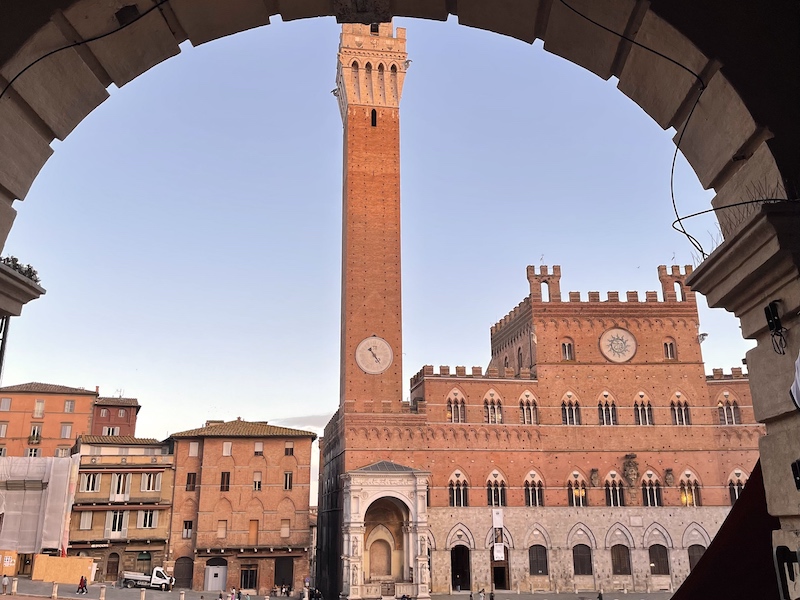
Stunning Siena offers a window into the Middle Ages like nowhere else in Italy. The city enjoyed its golden age more than 700 years ago, and so it's little surprise that the architectural majesty of the Romanesque and Gothic eras is everywhere you look.
Winding cobbled streets open without warning into wonderful piazzas lined with stately palaces and time-worn churches concealing all manner of glittering medieval altarpieces, mysterious relics and barnstorming frescoes.
At the center of the action is spectacular Piazza del Campo: twice each year the sweeping shell-shaped square is home to the world's craziest, most daredevil horse race, where steeds and riders from each of Siena's 17 tightly-knit contrade (neighborhoods) battle it out in a breakneck, bareback dash around the piazza in a contest that’s as thrilling as it is notoriously corrupt. The fix might be in, but it’s all part of the fun.
Stop into the Palazzo Pubblico, the political headquarters of Siena’s fearsome Council of Ten, to gaze on some of the finest masterpieces of the early Renaissance including the Lorenzetti brothers’ extraordinary Allegory of Good and Bad Government, and spend some time in the jaw-dropping Duomo - arguably the finest church in Tuscany. For a complete guide to what you need to see in Siena, see our dedicated article here: What to See in Siena: A Weekend in Italy’s Finest Medieval City.
How to Get There: Take a Trenitalia regional train from Santa Maria Novella directly to Siena (between 1 h 30 min and 1 h 50 min depending on the service)
2. Pisa
Yes, nearly everyone visiting Italy has Pisa right near the top of their bucket list, and yes, the Leaning Tower is every bit as impressive as you’d hoped. The iconic tower seems to defy gravity as its rows of delicate Romanesque arches list alarmingly off-kilter in the city’s otherworldly Piazza dei Miracoli. The nearby Camposanto cemetery is an enchanting jumble of funerary monuments and important frescoes, while the city’s adjacent cathedral and baptistery are unmissable in their own right.
There’s a lot more to Pisa than the stunning but tourist-clogged Piazza dei Miracoli, however. Venture beyond the famous landmarks and you’ll discover a vibrant modern city home to Italy’s most prestigious university, buzzing nightlife, great restaurants and a thriving cultural scene all unfolding amidst stunning Medieval and Renaissance monuments - testaments to Pisa’s one-time status as a vastly wealthy naval superpower whose fearsome fleets once controlled trade routes all across the Mediterranean.
Check out what you need to see in Pisa with our online guide here.
How to Get There: Hop on a direct Trenitalia regional train from Santa Maria Novella direct to Pisa Centrale (between 1 and 1.5 hours depending on the service)
3. Lucca
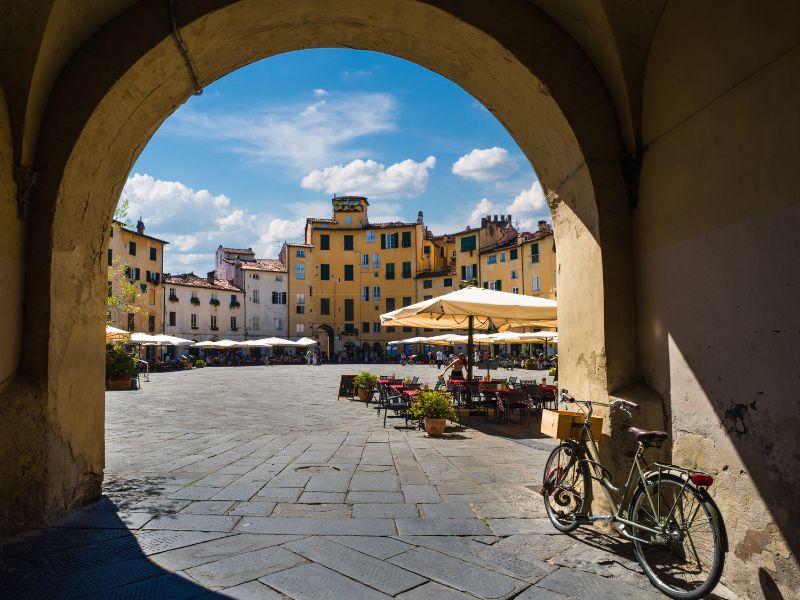 Photo by Thom Photography via Canva
Photo by Thom Photography via Canva
Elegant Lucca wears its many charms very lightly indeed - and you get the feeling locals are more than happy that it still travels under the radar of mass tourism. But although it doesn’t attract the fame of regional neighbor Pisa, this small city makes for a perfect day trip from Florence.
Protected all around by imposing Renaissance walls, self-contained Lucca is home to a marvelous 11th-century cathedral, a higgledy-piggledy pedestrianized historic center, and a slew of lovely bars and restaurants.
Look out too for some exceptional medieval towers: for stunning panoramas climb the Torre Guinigi, where seven oak trees grow improbably from its summit, and the Torre del’Ore - according to legend haunted by the ghost of local 17th-century beauty Lucida Mansi, who sold her soul to the devil in exchange for eternal youth.
One of the most fun things to do in Lucca is to take a spin along its surrounding walls. The ramparts of the 4-kilometer-long mura have been transformed into a lovely tree-lined walkway, offering up great views over the city and surrounding countryside. It’s the perfect location for a truly Tuscan evening passeggiata before enjoying an aperitivo in Piazza dell’Anfiteatro, which traces the shape of an ancient Roman amphitheater.
How to Get There: Take the Tuscany Line regional train operated by Trenitalia from Santa Maria Novella direct to Lucca station (1 h 20 min)
4. San Gimignano
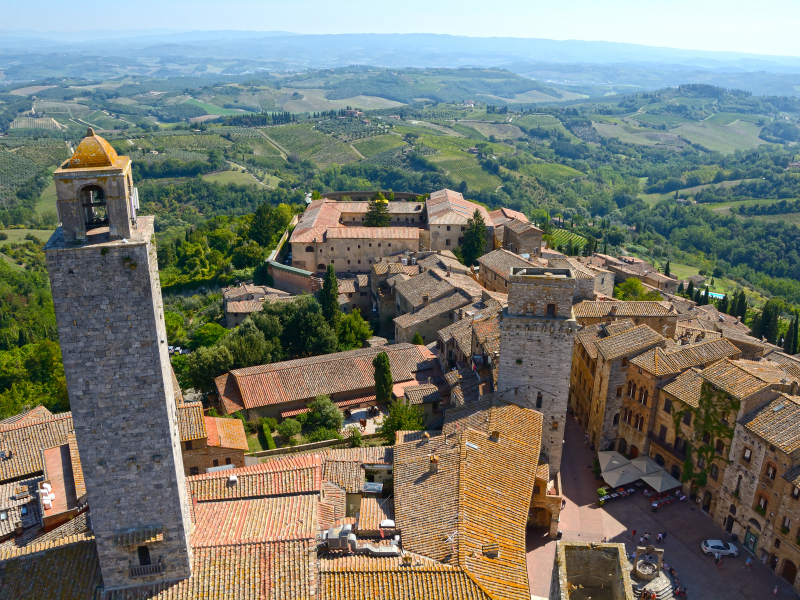 Photo by Madzia71 via Canva
Photo by Madzia71 via Canva
Poking up from the Tuscan landscape like some great brick porcupine, the skyline of San Gimignano is instantly recognizable. Although only 13 of its more than 72 medieval towers remain standing, they still stand as striking reminders of the town’s 13th-century Golden Age.
Named after a local bishop who reportedly rescued the city from the pillaging hordes of Attila the Hun, San Gimignano owed its medieval prosperity to the proximity of the Via Francigena, a pilgrimage route that led from Canterbury in England all the way to Rome. The Francigena doubled as a trade route, and San Gimignano emerged as a perfect stopover for the merchants, pilgrims and diplomats who passed by. The town soon became rich, helped along by the popularity of the locally grown saffron and Vernaccia wine.
Upwardly mobile families began competing with each other in ostentatious displays of wealth, emblematized in the increasingly tall fortified towers that they built as easily defendable family homes. The Black Death knocked San Gimignano’s prosperity on the head in 1348, and the town reverted to being a provincial backwater. But memories of its former glories are everywhere.
A visit to the Piazza del Duomo reveals the town’s rich political and religious legacy, with the lovely Romanesque Collegiata church featuring vivid frescoes such as Taddeo di Bartolo’s The Last Judgement and Ghirlandaio’s Life of Santa Fina. Nearby, the 13th-century Palazzo Comunale boasts amazing artworks (including a raunchy morality tale which features a very rare example of medieval nudity) in halls once graced by Dante himself. The church of Sant’Agostino, meanwhile, is home to another fabulous fresco cycle, this time by early Renaissance master Benozzo Gozzoli depicting the life of the eponymous saint.
When visiting San Gimignano, make sure to stop off at the gelateria Sergio Dondoli, purveyor of arguably the finest gelato in the world.
How to Get There: Take the train or the bus (route no. 131) from Santa Maria Novella to Poggibonsi, and change there for the bus (route no. 130) to San Gimignano (approximately a 2 hr journey overall).
5. The Cinque Terre
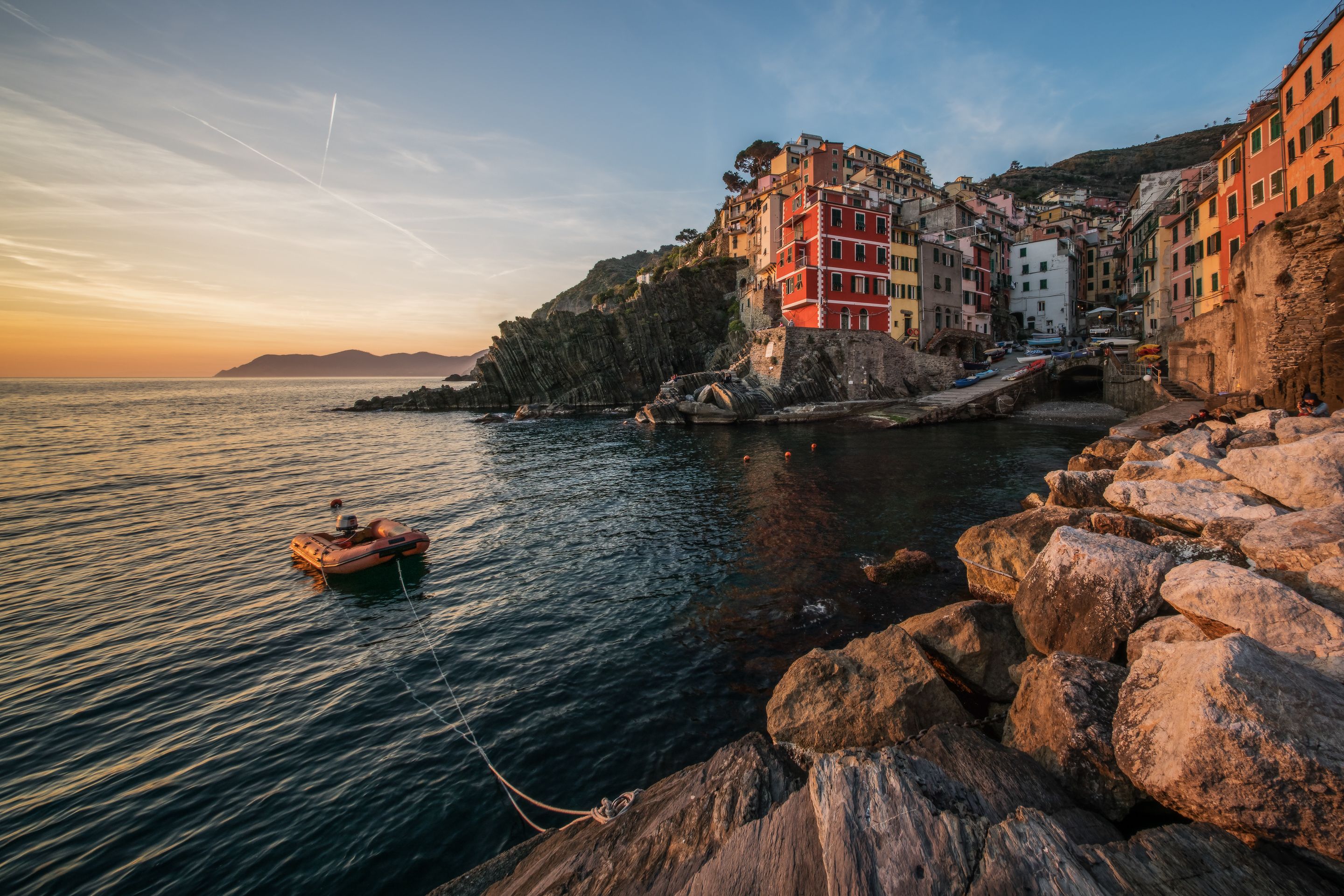
Ok it’s not in Tuscany, but the breathtaking scenery of the Italian Riviera along Liguria’s rugged coastline just to the north more than merits a day-trip beyond the region’s confines. The real must-visit destinations here are five small villages perched in spectacular cliffside settings known as the Cinque Terre.
The five towns that make up the Cinque Terre - Riomaggiore, Manarola, Corniglia, Vernazza and Monterosso - began life as medieval fortified settlements, each protected by a castle overlooking the sea guarding against Saracen raiders.
These days, the pirate threat is long gone, and the Cinque Terre’s picturesque pastel-coloured villages have taken their well-deserved place as a UNESCO World Heritage Site. It’s a long but doable day trip from Florence if you’re prepared to make an early start. Learn more about the delights of the Cinque Terre with our online guide here.
How to Get There: Take the Trenitalia regional train from Santa Maria Novella to La Spezia (2 h 30 min), then change onto the local Trenitalia line that serves the Cinque Terre coastline (another 10 - 20 minutes from La Spezia depending on your destination town).
6. Lago Trasimeno
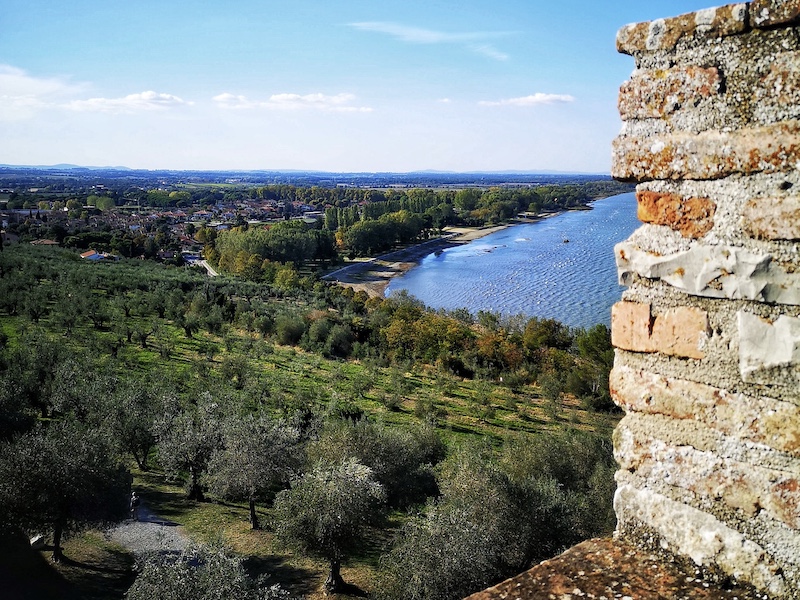
Located right on the border between Tuscany and Umbria, Lago Trasimeno is Italy’s fourth-largest lake. Surrounding the glittering expanse of blue, swathes of olive groves, sunflower fields and cypress forests extend in every direction to paint a very Mediterranean panorama in the green heart of Italy.
Towering above the waters of the lake is the town of Castiglione del Lago, where the medieval fortress known as the Rocca del Leone casts a baleful shadow over the surrounding countryside. I love exploring its ramparts and drinking in the magnificent views, often with hardly another visitor in sight.
Castiglione del Lago sits on the train line from Rome to Florence, so if you have a few hours to spare on your journey it’s well worth considering a stop for a tranquil afternoon by the lake!
How to Get There: Take the Trenitalia fast regional train towards Rome and get off at Castiglione del Lago (1.5 hours).
7. Pienza and the Val d'Orcia
Nestled in the rolling Tuscan hills in the Siena region, the small town of Pienza is an absolute delight. Known until the 15th century as Corsignano, for much of its history the town was little more than a rural backwater.
All that changed, however, when local luminary Enea Piccolomini was named Pope Pius II in 1458. Wanting to valorize his dilapidated birthplace, the pontiff decided to hire some of the leading architects of the age to transform the village into a model Renaissance town based on the latest principles of urban design. Naturally enough, the city was renamed after the pope himself.
The result is spectacular, with orderly palaces and churches - in particular the cathedral - unfolding in symmetrical harmony. If you want to really understand the principles that drove the Renaissance, then you need to come here.
No less impressive are the sweeping views from the town over the Val d’Orcia: this is the heart of Tuscan wine country, home to prestigious varietals such as Brunello di Montalcino that capture the magic of Tuscany in every sip. If you have a car, combining Pienza with Montalcino and San Quirico d’Orcia makes for a fabulous day long excursion.
How to Get There: To visit this region from Florence, ideally you’d rent a car. It is possible with public transport, however. One option is to take the train to Siena and change for a bus to Pienza serviced by the Tiemme company.
8. The Tuscan coastline
Most international visitors don’t come to Tuscany for a beach holiday, but the region’s coastline is one of the loveliest in all of Italy, characterized by pine forests sweeping down to endless sandy expanses and crystal blue waters.
There are plenty of great options for day trips from Florence if you want to take a dip, but the coastline around Castiglioncello is particularly beautiful - its cliffs and reefs are perfect for snorkeling.
If you have a car, then consider venturing a little further south to Porto Ercole. Perched on the dramatic Argentario promontory, connected to the mainland by only the slimmest of land bridges, this charming little town unfolds over two levels - the historic upper old town where a Norman castle stands watch over the waves, and the more modern development down on the shoreline.
Art history buffs will know Porto Ercole for different reasons. It was here, on the long sandy beach of La Fenice, that the great Baroque painter Caravaggio contracted the malarial fever that would kill him, as he desperately sought to make his way back to Rome after years on the run as a fugitive from the law.
How to Get There: There are some direct trains from Santa Maria Novella to Castiglioncello, but currently the only viable option for a day trip leaves very early in the morning. If you don’t fancy a dawn wake up call, then take the train to Pisa (see above) and change there for a connecting train to Castiglioncello (between 1 hr 40 min and 2 hours all in). For Porto Ercole you’ll need a car.
9. Arezzo
Another Tuscan big-hitter, Arezzo was the birthplace of the poet Petrarch, the artist Michelangelo and the painter-historian Vasari (whose house, now a museum, is well worth a visit for the artist’s own decorations) - giving you an idea of what lies in store when you come to visit. Yes, this is a city of culture par excellence.
It’s another local lad who conjured up the city’s greatest artistic masterpiece, however. Piero della Francesca’s Stories of the True Cross cycle in the Basilica di San Francesco’s Bacci Chapel traces the legendary tale of the cross upon which Christ was crucified through various vicissitudes over time - from its genesis at the death of Adam through to its central role in the conversion of Constantine to Christianity, signaling the end of pagan Rome.
Simply put, this is one of the greatest achievements of Renaissance art anywhere, and worth the trip to Arezzo all on its own.
Even if you’re not the world’s biggest art connoisseur, however, there’s plenty more to keep you entertained on a day trip to Arezzo. The city’s historic center is absolutely stunning, and is home to an array of historic cafes, enticing bakeries, buzzing bars, elegant boutiques and top-tier restaurants offering up the very best hospitality and cuisine that Tuscany can offer.
The beating heart of the city is Piazza Grande, a jaw-droppingly beautiful square that is spectacularly decorated with Christmas lights each Christmas and which plays host to a superb antiques fair on the last Saturday and first Sunday of each month.
How to Get There: Take a fast regional (1 hour) or normal regional (1 h 30 min) train direct from Santa Maria Novella.
10. Volterra
A beautiful Tuscan town whose forbidding medieval walls and mysterious air inspired Stephanie Meyer to base a coven of well-heeled vampires here in Twilight, Volterra has been dubbed the most under-rated hilltop destination in Italy by no less an authority than Rick Steves himself. And it’s easy to see why. Volterra remains refreshingly untouristy compared to places like San Gimignano, and easily retains the kind of authentic, local feel that most travelers to this part of Italy crave.
Volterra is more than just a pretty face: long before the Romans became top dog on the Italian peninsula, this was the heartland of the mysterious ancient Etruscan civilization. The massive, stone-hewn remains of Etruscan architecture dotted around the town give Volterra a truly ancient feel, and the precious artworks and artifacts in the local museum help to round out our picture of this distant people.
Roman finds are just as interesting, including one of the country’s best preserved ancient theaters, while medieval Volterra is well represented in the Duomo, Baptistery and magnificent Palazzo dei Priori. Beyond the landmarks, though, perhaps the greatest of Volterra’s greatest charms lie in aimless wandering, stopping off here for a glass of local wine, there to browse the artisan alabaster for which the town is famed. This is Tuscany at its cinematic best.
How to Get There: Take a Trenitalia regional train from Santa Maria Novella to Pontederra station and change to the bus line 500 to Volterra. The bus station in Pontederra is about a block away from the train station.
MORE GREAT CONTENT FROM THE BLOG:
- Everything You Need to Know to Visit Florence in 2024
- The Best Things to Do in Florence in 2024
- Where to Stay in Florence
- The Best Tours of Florence
- The Best Museums in Florence
- What to See in the Uffizi Gallery
- The Best Street Food in Florence
- Where to See Michelangelo in Florence
Through Eternity Tours offer a range of insider itineraries in Florence and Tuscany, so if you’re taking a trip to Florence this year check out our website or get in touch with our expert travel planners today!



